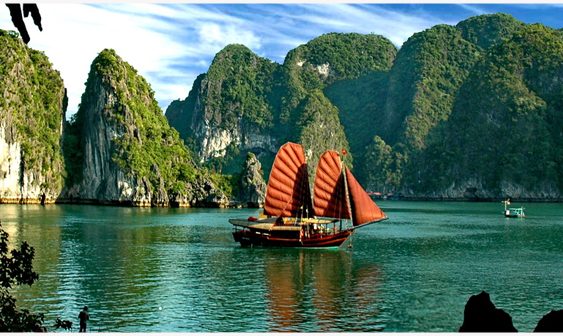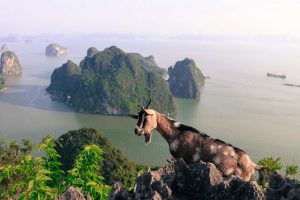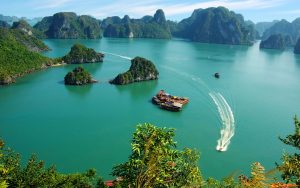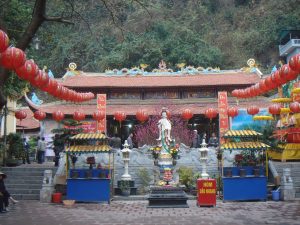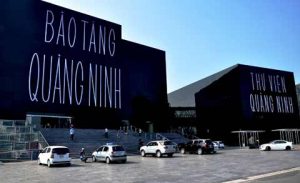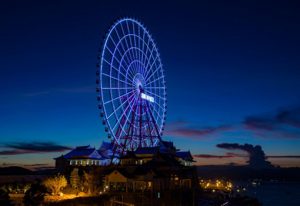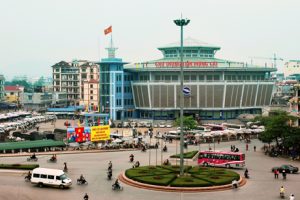1- Bai Tho Mountain (Poem Mountain)
Distance from the center of Halong city: 01km
Discovering the beauty of Bai Tho Mountain (Poem Mountain)
When it comes to Halong, people often think of Halong bay – the World Natural Heritage, sprawling white beaches, Thien Cung Cave, Titov Island and attractive specialties … But there is a place in Halong you should not miss in your trip, it is Bai Tho Mountain or Poem Mountain – a famous poetic and lyrical image of Halong bay with its charming beauty.
With the height of about 200 meters, Poem Mountain is one of the highest mountains in the Cua Luc Sea. The mountain is not only adjacent to the residential area but also near the sea; so that from the mountain, the visitors may have a good view to see the surrounding scenes especially the view of luxury yachts travelling on the bay with mighty stone pillars in the blue of the sky and the water. It is said that, to enjoy the beauty of Halong bay completely, the only way is to climb on the top of Poem Mountain to see the bay. It is a distinctive view of the bay that can help you to feel the magnificent and fabulous beauty of the Northwestern sea and sky. Moreover, the fresh and open atmosphere in the top of the mountain can make you feel comfortable and pleasant after tired climbing.
The former name of the mountain is Truyen Dang Mountain (also called Roi Den Mountain). It is not without reason that the mountain is called Roi Den. Long ago, the frontier soldiers on the mountain used to set a fire and lighten the beacon to show the signals for boats in the sea off. Until when the king Le Thanh Tong wrote a poem on the cliff of the Mountain, the name has changed up to now. Situated in the center of Halong city, Poem Mountain looks like a 3-floor tower when being seen from a far distance. The mountain has many culture values as well as historical values. Indeed, beside many cultural relics – the ancient poems of King Le Thanh Tong and sages craved on the cliffs, the mountain is the hiding place for our army in fierce war time of the war against the United States in 20th century. It can be said that, the beauty of the mountain and the bay had seduced many poets and artists to create many art masterpieces for the descendants including King Le Thanh Tong and Trinh Cuong … In the root of the mountain, there is a pagoda which is called Long Tien. Being built in 1940 with special and impressive architecture, the pagoda is set up by the local residents to worship Buddha for a better life and good weather for fishermen. The pagoda is considered as the biggest pagoda in Halong city. Near the pagoda, there is a trail lead to the peak of the mountain. Visitors should come to the pagoda to visit and pray before starting to climb up to the mountain. The way to the peal of the mountain is not easy to climb, it is quite adventurous for you to go up when you have to grip onto the cliffs and watch the trail carefully. However, along the route to the top of the mountain you can see the goats and even naughty monkeys; blooming wild flowers and colorful butterflies float around you.
When reaching the top of the mountain, you seem to become a giant; all the things under the mountain are small even mighty stone pillars on the bay. All the tiredness when climbing are faded out with the blowing wind and the fresh air. It is very fantastic!
2- Ha Long Bay
Halong Bay is located on the Western side of the Gulf of Tonkin in Northeastern Vietnam. The bay is approximately 35 km (21 miles) Northeast of the port city of Hai Phong and approximately 170 km (105 miles) by road from the capital Hanoi. The town of Halong is situated on the coast to the North of the bay. The journey from Hanoi to Halong takes approximately 3.5 hours.
Halong Bay is formed by Cat Ba island to the South, Ngoc Hung and Van Canh islands to the East and the Vietnamese coastline to the North and West. The bay covers a total area of 1,553 square kilometers (600 square miles). Occupying the heart of the bay between Halong town and Cat Ba island, the central World Heritage area stretches for 434 square kilometers (167 square miles).
Natural Features
Islands and Karsts
The most outstanding feature of Halong Bay and undoubtedly its greatest attraction are the 1,696 islands, islets and rocky karst outcrops. 989 of these islets and rocky outcrops have been been given imaginative names by the locals over the years. These have been derived from their perceived shapes and include names such as Man’s Head, Fighting Cocks, Wading Ox and Wallowing Buffalo.
With heights ranging from 50-100 meters (160-330 feet) and a height-to-width ratio of about 6:1, the majority of these karst pinnacles and islets have sheer, vertical cliffs. They are uninhabited and unaffected by human activities. The pure size and numbers of these outcrops provide a stunning contrast and backdrop to the turquoise waters of the bay when viewed from sea level.
Caves and Grottos
Another exceptional geological feature of Halong Bay is the number of limestone islands which have caves and grottoes within them. The total number of caves has never been determined and there are almost certainly more which are yet to be discovered. In order to preserve the natural state and integrity of the large number of caves and grottos in the World Heritage Area, only some are open to visitors. The most commonly visited are Thien Cung (Heavenly Palace) cave, Dau Go (Wood Tip) grotto, Sung Sot (Surprise) cave and Trinh Nu (Virgin) grotto.
The shapes and formations on the sides and rooves of the caves, many now being part of local folklore and legends, bear witness to the different stages of formation over the ages. Some cave features, such as calcified shell-beds, are the direct result of ancient human activity.
Sea and Lakes
The lower chambers of some caves and grottos are below sea level. Due to the porous nature of limestone, these chambers are often partially filled to form tidal lakes and pools. Although most of these are shallow, the depths of some have never been determined. The geomorphology of Halong Bay indicates that it is almost certain that there are undiscovered and fully entombed lakes within many of the islands. Dau Be (Goat’s Head island) alone has 6 different tidal lakes.
The sea in Halong Bay is generally less than 10 meters (33 feet) deep and boasts a rich biodiversity of about 1,000 species of marine animals. Over 160 species of coral have been identified. Coral reefs make up 30% of the seabed and in some areas as much as 80% of the seabed is covered in coral reefs. Most coral reefs are at a depth of 4-6 meters.
3- Long Tien Pagoda
Distance from the center of Halong city: 350 meter
Long Tien Pagoda is located at the foot of Bai Tho Mountain, Long Tien Street, the Pier Hotel in Hon Gai and is the largest pagoda in Ha Long City. It was built in 1941 to worship Buddha and generals of Tran Dynasty who had merits of the country. On the Lunar New Year, full moon day, the first of every month, Long Tien Pagoda attracts many locals and tourists who are Buddhist followers from everywhere.
Although the new temple was built in the mid-twentieth century, but the style is the unique architectural style of Nguyen Dynasty. The Tam Quan (three-entrance gate) includes 3 doors: Huu, Vu and Dai. Atop of the three-entrance gate stands a statue of A Di Da, bellow it is a bell-tower. Outside of the three-entrance gate stands statue of Bo De Dat Ma, the Patriarch of Chinese and Vietnamese Zen. In bai duong and the main altar of the pagoda stand worshipping statues.
Additionally, over the sanctum yard, on the roof with transplant recipient ceramic dragons, flanked provision described property. In the main hall on the third gate, braille Nagarjuna Korea, People’s shortened called Long Tien Pagoda. In Long Tien Pagoda has many sentences, the sculpture itself is very sophisticated, demonstrating a high level of sculpture. In particular, the temple is the famous Mekong depicting nine dragons flanking the Buddha; this is the delicately carved wood. Although, in the heart of downtown Ha Long City, Long Tien Pagoda still damns purity of the ancient temple, visitors can find moments of peace when the temple sightseeing…
In addition to beauty, Long Tien Pagoda also attracts tourists with Long Tien Pogada Fesstival which is opened on the 24th day of the third lunar month. The festival involves palanquin procession which starts from Long Tien Pagoda, then Duc Ong Temple to An Duong Vuong Temple and return. Traditional folk games in the festival, such as: Chinese chess, wrestling, Chau Van singing, Cheo performance, etc.
Long Tien Pagoda is really an attractive destination in your Halong traveling. In addition to enjoy its beauty, you also have chance to study about Vietnamese culture when joining Long Tien Pagoda Festival with Chau Van singing and Cheo performance.
4- Quang Ninh museum
Distance from the center of Halong city: 03 KM
Designed by Spanish architect, Salvador Perez Arroyo, started to build in the end of 2012 and completed in October 2013, Quang Ninh Museum and Library is located on an area of nearly 24,000m² with a total investment of over VND 900 billion. It includes 3 blocks of museum, library and convention connected together by an overhead bridge system. Inspired by the icon of coal, a typical mineral of Quang Ninh Province, the building is a symbol on the most beautiful coastal road in Ha Long City. Especially, the building is assembled with 14,000m² of glass that has resistant to temperature changes. Thanks to specific architecture, the building looks like a giant mirror reflecting the image of the world natural heritage, Ha Long Bay.
As soon as entering the ground floor of the museum block, visitors will have the chance to admire a whale skeleton and sailboat models. The first floor features tubular displaying columns made of modern materials such as steel frame, tempered glass and especially the covering fabric with images of Ha Long Bay combined with light projection technology to make visitors feel like walking in a miniature space of Ha Long Bay. The second floor is designed according to a wooden boat to introduce Quang Ninh Province through periods of prehistory, proto-history, Bach Dang victory, resistance war against French Colonial and American Empire, and Truc Lam Yen Tu Buddhism culture. In the third floor, visitors will visit display spaces of economic achievements, cultural identities and characteristics of ethnic groups in Quang Ninh Province; images of visits of President Ho Chi Minh to Quang Ninh; and artifacts used in mining, especially coal industry.
Besides the museum, the library block is also designed in a modern style, of which the ground floor stores over 100,000 book titles of all fields. The first floor consists of conference rooms, rooms for children, a screening room, a theater and a coffee shop. The pendent floor has room for businessmen, display room of books and newspapers, foreign language book room, internet room… The second floor is composed of general reading rooms, reading rooms for the disabled, a general book warehouse with over 200,000 titles and a conference rooms with the capacity of over 60 people.
Connected with famous attractions in Quang Ninh Province such as Bai Tho Mountain, Tran Quoc Nghien Temple, Long Tien Pagoda, Hong Gai Church, Ha Long Marine Plaza, Vincom Ha Long Trade Centre…, Quang Ninh Museum and Library is a specific tourism product containing the values of daily lives of local people.
Currently, Quang Ninh Museum and Library is open from 9h00 to 11h30 and 14h00 to 18h00 (Tuesday to Saturday). The building is contributing to promoting the image of Quang Ninh tourism to domestic and international tourists.
5- Sun World Halong Park
Distance from the center of Halong city: 8,5 KM
Sun World Ha Long Park, a megaproject at continental-level including exclusive and innovative parks, is the largest tourist – recreational complex of Vietnam. Visiting Sun World Halong Park makes you feel living in a mysterious “Dragon land” with plenty of captivating and novel attraction.
Featuring a total area of 214 ha, Sun World Ha Long Park consists of 2 main sectors linked by a sea-crossing cable car line: Beach amusement complex and Mystic Mountain complex
The 2-km long cable car will take visitors to the Mystic Mountain complex. There are numerous activities and things to see including the Zen garden, coin-op games and Sun Wheel – world’s top highest ferries wheel.
Sun World Halong Park is a product of Sun Group, one of the leading corporations in investment and construction of amusement complex and resorts such as Ba Na Hills, Asia Park, Fansipan Legend… With the experience and reputation of Sun Group, Sun World Halong Park is on its way to become a world-class amusement spot and attraction in Vietnam.
Sun Wheel
Located atop of Ba Deo mountain at nearly 250m above the sea-level, Sun Wheel places among the top world’s tallest sightseeing Ferris wheels. Sun Wheel Ha Long, featuring a total of 64 cabins with 384 passengers and a capacity of 1.200 passengers/hour, promises to provide visitors with a brand new outlook while gazing down the breath-taking panoramic landscape of Ha Long Bay. Constructed by the Japanese corporation Sanoyas Hishino Meisho, Sun Wheel will be a remarkable sight in Ha Long covered by tens of thousands of colorful LED lights.
Queen Cable Car
The journey across Halong Bay by Queen cable car, joining Ocean station with Sun station with the Queen cable car line, is a fantastic experience not to be missed in Sun World Halong Park. This is the only path connecting the beach amusement complex with the mount of Ba Deo. Visitors can enjoy the ride contemplating the marvellous panoramic beauty of Ha Long Bay from atop. Queen Cable car, the first reversible gondola system in Asia with duplex cabin, has achieved 2 Guinness World Records:
– Highest passenger capacity in a cable car cabin (230 passengers per cabin)
– Tallest cable car tower (188,88 meters)
6- Quan Lan Island
Distance from the center of Halong city: 1,5 hour by speed boat
Located in Bai Tu Long Bay, Quan Lan Island (Van Don District, Quang Ninh Province) has become an ideal destination in summer holidays. From Cái Rồng Port, visitors take about one hour by speedboat to discover Quan Lạn Island.
Quan Lan Island includes 3 beaches of Quan Lan, Son Hao and Minh Chau with pristine beauty, clear blue seawater and fine white sand bank stretching along the green rows of casuarinas. Not only fascinated by the beautiful beaches, Quan Lan Island also has a range of relics imbued with cultural identity of region known as one of the best commercial ports in Viet Nam, typically Quan Lan Communal House – one of two oldest communal houses in Quang Ninh Province. It was built in the Post Le Dynasty (about the 17th century), dedicated to King Ly Anh Tong (1138-1175), Tutelary God and predecessors who established the village. The communal house’s architectural works consists of forecourt and harem, with scale tiled roofs, the rooftops in shape of two dragons flanking a moon. The communal house has 32 main pillars, 26 small pillars made of precious wood, doors and tie-beam finely carved designs of dragon, phoenix, flower…
Where to visit in Quan Lan island
Quan Lan Communal House – is one of the two most ancient communal houses in the northern province of Quang Ninh. Built under the dynasty of Post King Le in 17th century, this communal house was said to dedicate to King Ly Anh Tong (1138-1175), Tutelary God and predecessors who had played important roles in establishing the village. The communal house’s architectural works comprise forecourt and harem, with scale tiled roofs, the rooftops in shape of two dragons flanking a moon. There are 32 main pillars, 26 small valued wooden pillars and doors together with tie-beam finely carved designs of dragon, phoenix, flower, etc. at the communal house.
Quan Lan Pagoda (also called Linh Quang Pagoda) is located near Quan Lan Communal House. It is dedicated to Buddha and Mother Goddess Lieu Hanh. The pagoda is used to preserve statues of Buddha. Lying adjacent Quan Lan Pagoda is Quan Lan Temple which is dedicated to three brothers of Pham Cong Chinh, Pham Quy Cong and Pham Thuan Dung, who bravely sacrificed in the battle of van Don – Cua Luc against the Mongol invaders in 1288.
In 1990, the historical complex of Quan Lan Communal House, Pagoda and Temple was acknowledged as National Art Architectural – Historical Relic.
7- Mong Cai – the border city
Distance from the center of Halong city: 140km
For many years, Mong Cai in Quang Ninh Province has been known as the “shopping heaven” of Vietnam. It is the most bustling trade centre in the north-eastern regionand a dynamic young city in Vietnam.
The city of Mong Cai, previously known as Mang Nhai, is nearly 200km northeast of Ha Long. The city has a favourable geographic position and plays a crucial strategic role in terms of politics, economics, defence-security and external relations because it has international border gates both on the road and in the sea, connecting Vietnam with China and other countries in the world.
For the above reasons, Mong Cai was first formed as an experimental economic zone in Vietnam, starting in 1996. With its advantage of having a long borderline near Guangxi, China, the city’s economy has strongly developed with the establishment of a series of trade centres and a system of restaurants and hotels from common to luxurious, so it is no exaggeration to say that Mong Cai is the “shopping heaven” of the northeastern region of Vietnam.
The city of Mong Cai is like a complex of trade services with trade centres, supermarkets, restaurants mushrooming along the spacious and modern roadsof Hoa Binh, Hung Vuong, Huu Nghi and Tran Phu.
At present, Mong Cai has 14 markets and large trade centres, mainly at the heart of the city with thousands of small and large shops. It is the wholesale market for customers in the north. The central market of Mong Cai located on Tran Phu Street every year attracts the largest number of customers nationwide. The others, Mong Cai 2 and 3, are also situated on Tran Phu Road, 1km from the Bac Luan Border Gate. These markets and Vinh Co Trade Centre are ideal places for buying electronics.
This young border city boasts its Mong cai International Border Gate which is the busiest trade gateway in the northeast, connecting the city of Mong Cai with Dongxing (China) and helps the city develop tourism. From this border gate, tourists easily fulfill procedures for travelling to coastal provinces of China. The city boaststhe Ka Long River which forms a natural border line of 60km between Mong Cai, Quang Ninh Province and Dongxing of Guangxi, China. It is the busiest and most important river border gate of Vietnam-China trade. Crossing over the river is the Ka Long Bridge, the city’s symbol which was designed by a French architect and built in 1964. The only stone-built bridgeis now one of the most popular destinations in the city together with the Mong Cai International Border Gate, Sa Vy Border Propaganda Complex, Tra Co Church and Xuan Lan Pagoda.
With its advantages in terms of geographic position, natural landscape and economic potential, Mong Cai was planned by the Government to develop into the Mong Cai Border Gate Economic Zone by 2050. Under the planning, the economic zone will have a total area of 121,197ha, including a total land area of 66,197ha and a water area of 55,000ha. It is expected to become a dynamic economic growth pole of the Red River delta, a developed economic centre on the coastal economic belt of the Tonkin Gulf and an important gate for trade and international cooperation between Vietnam and China and other ASEAN members. In the future, Mong Cai – the border city of the country is expected to develop into a trade centre of regional stature.
8- Binh Lieu district
Distance from the center of Halong city: 120km
Binh Lieu is a district of Quang Ninh Province that has international frontier with China. Many Vietnamese people compare Binh Lieu as the Sapa of North-East Vietnam. The district is the home of some ethnic groups, such as: Dao, Tay, San Chi. Visiting Binh Lieu, you have chance to discover the beautiful terraced fileds, springs, waterfall, Dao ethnic group village and especially the multi-colored traditional custom of local people.
— internet source —


